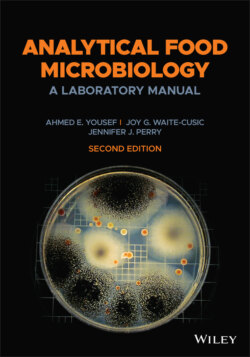Читать книгу Analytical Food Microbiology - Ahmed E. Yousef - Страница 9
Оглавление
PREFACE
Microbiological testing of food is an important component of the global food system. Results from these tests support food safety and quality programs by helping researchers and processors monitor fermentations, validate and verify the efficacy of processing treatments, and demonstrate the efficacy of sanitation programs. Well‐trained food microbiologists are needed in the food industry, supporting industries, and regulatory agencies to conduct laboratory analyses that serve these functions.
There is no shortage of published methods for enumerating food microbiota or detecting foodborne pathogens. However, using these methods in teaching or training settings requires considerable adaptation and simplification. Professional analysts have an eight‐hour work shift, which provides ample and flexible time to complete a variety of microbiological analyses. On the contrary, most teaching laboratory or training sessions are short, often less than three hours; therefore, the use of official and standard methods in teaching and training environments is impractical.
Many of the methods presented in this book were designed from the authors’ combined experiences as microbiologists in academic, regulatory, and industry laboratories. Starting decades ago, with simple teaching exercises at the Ohio State University, we built full analytical protocols that echo recent advances in science yet are executable in diversely equipped laboratories, albeit to different degrees of completeness. The laboratory exercises have been structured so that each provides students or trainees an opportunity to learn a new technique or approach in microbiology. The learning objectives are listed explicitly below each exercise title and explained in detail within the body of the exercises. The book’s initial exercises meet the needs for basic training in food microbiology; these activities also prepare students and trainees for more advanced training in subsequent exercises.
The book has four main parts. The first part covers safety considerations and reviews basic microbiological techniques that may have been covered in previous introductory biology or microbiology courses. Included in Part I are simple exercises to help students with limited background in applied microbiology or to refresh experienced students with essential microbiological techniques. This part also emphasizes terminology and sets the stage for the approaches used in the remainder of the book. Part II includes exercises to evaluate various microbiological groups of significance to food quality, starting with mesophilic aerobic bacteria and ending with foodborne fungi. Pathogen detection is covered in Part III of the book. Both culture‐ and molecular‐based approaches are included in this section. Part IV covers the microbiological aspects of technologies used in the control of food microbiota. Included in this part are two exercises that familiarize students with microbiological control by thermal treatments and antimicrobial peptides.
This book evolved from simple exercises that have been offered as a food microbiology laboratory course at the Ohio State University (OSU), Columbus, Ohio, USA, since the early 1990s. As the course became popular, interest in documenting these exercises into a published book was expressed by OSU alumni as well as colleagues from other institutions, including those from developing countries. In response to this interest, the teaching methods were compiled in the Food Microbiology Laboratory Manual, which was authored by A. E. Yousef and C. Carlstrom and published in 2003 by John Wiley. The book became a popular textbook in several universities and its Spanish translation was published in 2006 in Spain. Considering the continuous advances in the food microbiology field, it took great effort to evolve course methods and test them repeatedly before offering them to the students as teaching exercises. Although many teaching assistants over the years helped with this effort, the contributions of Joy Waite‐Cusic and Jennifer Perry were the most significant. They continued to develop and test these exercises post‐graduation from OSU, and while they serve as faculty members at Oregon State University and University of Maine, respectively. Both J. Waite‐Cusic and J. Perry are co‐authors of the current book.
Methods included in this book were customized to fit two‐hour laboratory periods and for a class that meets two or three times per week for at least 12 weeks per semester. Like any methodology publication, users may find errors or points of confusion despite our best efforts. These will be reported and corrected when future versions of the book are developed.
We recognize and appreciate the help we received from many teaching assistants, staff members, and visiting scholars while preparing and refining the exercises in this book. Many teaching assistants have contributed to the annual offerings of the Food Microbiology Laboratory course at OSU. They alerted us to exercise shortcomings, suggested solutions, and even tested corrective measures. We particularly appreciate the help we received from C. Carlstrom, A. Abdelhamid, E. Huang, Y‐K. Chung, and B. Lado‐Diono. Matthew Mezydlo, Department of Microbiology, OSU, shared his excellent microbiology expertise and provided valuable advice that was integral to the success of our effort. We also thank the hundreds of students at OSU who have practiced these methods over the past three decades and pushed us to provide a better compilation of exercises. A special thank you goes to Dr. Patrick Dunne, who was a great supporter of our effort in putting this book together.
Ahmed E. Yousef Professor, The Ohio State University, Columbus, Ohio, USA
Joy G. Waite‐Cusic Associate Professor, Oregon State University, Corvallis, Oregon, USA
Jennifer J. Perry Associate Professor, University of Maine, Orono, Maine, USA
